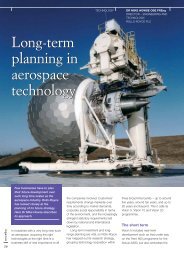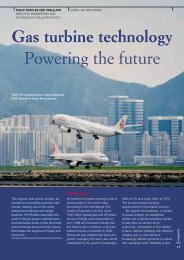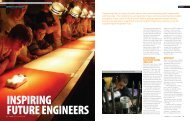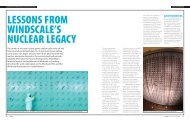Engineering ethics Engineering ethics - Ingenia
Engineering ethics Engineering ethics - Ingenia
Engineering ethics Engineering ethics - Ingenia
Create successful ePaper yourself
Turn your PDF publications into a flip-book with our unique Google optimized e-Paper software.
PROFESSIONAL ISSUES<br />
ingenia<br />
48<br />
article. In Canada and Australia,<br />
development has occurred through<br />
disciplinary proceedings brought against<br />
individual engineers. In the United<br />
Kingdom there are few instances of any<br />
such actions and, as yet, nobody of<br />
collective learning or experience to form<br />
the basis of a study of engineering <strong>ethics</strong>.<br />
This is in complete contrast to the field of<br />
medical (now renamed bio-) <strong>ethics</strong>, in<br />
which many cases involving ethical<br />
issues have been brought before Courts<br />
(including the European Court of Human<br />
Rights). In the field of engineering, while<br />
ethical questions can be identified as<br />
arising in many recurrent situations, the<br />
analysis and resolution of such questions<br />
must be approached on an ad hoc<br />
basis, with no more than general<br />
principles as guidance. The importance<br />
of these issues is such that systematic<br />
study and reporting is overdue.<br />
This article addresses the limited and<br />
practical questions involved in actions<br />
by individual engineers seeking to give<br />
warnings of preventable disasters. The<br />
consequences of such unauthorised<br />
disclosure are considered, together with<br />
alternative means of seeking to achieve<br />
disclosure. The article includes a review<br />
of practices, primarily in the USA, in<br />
relation to amicus or intervention<br />
proceedings, usually in consequence of<br />
actions taken by engineers to secure<br />
disclosure in pursuance of a perceived<br />
ethical duty.<br />
Warnings of preventable<br />
disasters<br />
A great deal of the literature published<br />
on engineering <strong>ethics</strong> in the USA is<br />
concerned with the actions of individual<br />
engineers in the face of actual disasters<br />
which can be seen to have been<br />
preventable. Perhaps the most appalling<br />
and thoroughly researched incident was<br />
the loss of the space-shuttle Challenger<br />
in 1986. This followed clear warnings by<br />
engineers from the Morton-Thiokol<br />
company, manufacturers of the solidfuel<br />
booster rockets, as to the danger of<br />
launching the vehicle at low<br />
temperature. The engineers’ warnings<br />
This … raises fundamental issues as to the<br />
actions that ought to be taken by those in a<br />
position to understand fully the implications<br />
of foreseen technical hazards …<br />
were overruled by a management<br />
decision. This case raises fundamental<br />
issues as to the actions that ought to be<br />
taken by those in a position to<br />
understand fully the implications of<br />
foreseen technical hazards. Likewise,<br />
numerous cases concerning the nuclear<br />
industry, airlines, the motor industry and<br />
most other branches of engineering,<br />
have provided a rich source of practical<br />
materials, forming the basis of the study<br />
and indeed the teaching of engineering<br />
<strong>ethics</strong> in the USA.<br />
The UK has suffered its share of<br />
engineering disasters. Few have given<br />
rise to issues comparable to the spaceshuttle<br />
Challenger. Many, however, have<br />
revealed deep-seated management<br />
problems, particularly a succession of<br />
serious railway accidents which have<br />
been fully investigated and reported. 6<br />
All such accidents can be seen to have<br />
been preventable in hindsight, often by<br />
the timely intervention of professional<br />
engineers. In 1991, The Royal Academy<br />
of <strong>Engineering</strong> (then the Fellowship)<br />
published proceedings of a conference<br />
on ‘Preventing Disasters’; this included<br />
‘draft’ guidelines for warnings of<br />
preventable disasters. The guidelines<br />
were offered to the professional<br />
Institutions for consideration. 7 The<br />
guidelines note that engineers:<br />
‘are placed under a professional duty<br />
to uphold the safety of the public and<br />
the environment by the code of<br />
conduct of their Institutions and<br />
organisations. A reciprocal<br />
responsibility is placed on the<br />
Institutions and organisations to assist<br />
any member who turns to them for<br />
help in furthering this duty…’.<br />
The guidelines state that many<br />
organisations have established<br />
procedures and that engineers should<br />
work within those procedures where<br />
they exist. The guidelines emphasise the<br />
need for the engineer to stay within his<br />
or her existing framework of<br />
responsibility by passing on warnings to<br />
others in a position to take action and to<br />
those ultimately responsible for resolving<br />
the situation. Individual engineers are<br />
encouraged to consult others or obtain<br />
guidance from the relevant chartered<br />
engineering institution. The notes state<br />
that informal warnings should be<br />
followed by a formal written statement<br />
and that this process may involve senior<br />
executives or ministers. Guidelines and<br />
notes are, however, infused with concern<br />
about legal liability as well as<br />
confidentiality. 8 The document<br />
represents an important if somewhat<br />
circumscribed recognition of the action<br />
that individual engineers should take in<br />
practice, given the practical constraint of<br />
working in an employed role.<br />
The papers published in the volume<br />
of proceedings bear out the complexity<br />
of any real life situation in which an<br />
engineer is faced with the burden of<br />
passing on a warning of perceived<br />
danger. The papers indeed demonstrate<br />
the way in which even well-expressed<br />
principles and guidance can be of little<br />
assistance when faced with the need for<br />
practical action. The most valuable<br />
contribution to the collection is a paper<br />
by the late Dr Edmund Hambly FREng, 9<br />
describing two situations in which, as an<br />
independent consultant, he had been<br />
driven to act. He describes the<br />
difficulties that lay in the path of<br />
attaining appropriate action, inevitably<br />
involving serious economic<br />
consequences. Dr Hambly’s examples<br />
concerned major structures where,<br />
largely through the effect of carefully



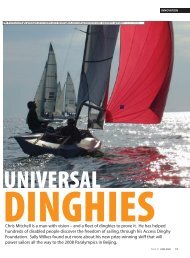

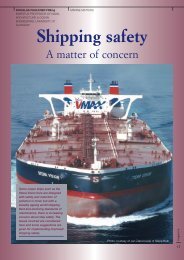

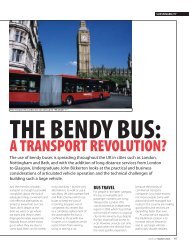
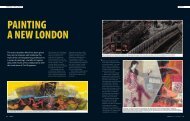
![[322/03] Francke - Ingenia](https://img.yumpu.com/23411337/1/184x260/322-03-francke-ingenia.jpg?quality=85)

